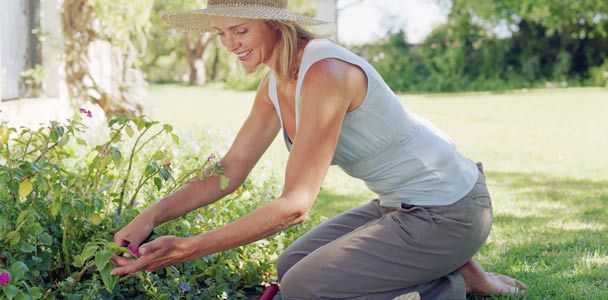Gardening is a rewarding hobby that allows you to connect with nature and cultivate beautiful landscapes. However, the physical demands of gardening can lead to discomfort or pain. This guide will explore strategies and tools to help you maintain the right posture and positioning while gardening for a more pain-free and enjoyable experience.
Proper Posture in Gardening
Maintaining good posture while gardening helps prevent strain and injury to your body. Proper positioning helps distribute your weight evenly, reducing stress on your muscles and joints.
When standing, keep your back straight with your knees slightly bent and your neck and shoulders relaxed. This alignment creates better balance and reduces the risk of back pain or muscle fatigue.
Avoid bending from the waist for tasks that require you to work close to the ground. Instead, kneel on a cushion or sit on a low stool. By adopting these habits, you can reduce the risk of developing chronic pain or injuries associated with prolonged gardening.
Equipment for Ergonomic Gardening
Investing in the right tools and equipment can make a big difference in your gardening comfort. Here are some tools and equipment that can add both comfort and functionality.
Cushioned Kneelers and Garden Seats
Cushioned kneelers provide a comfortable surface for your knees when working on the ground. Many kneelers also double as seats. These tools help reduce strain on your knees and back, allowing you to work comfortably for longer periods.
Long-Handled Tools
Tools with extended handles, such as rakes, hoes, and pruners, allow you to maintain a more upright posture while working. This reduces the need for bending and stretching, which can strain your back and shoulders. Look for lightweight options with ergonomic grips for more comfort and control.
Raised Garden Beds
Raised beds elevate your planting area, making it easier to tend to your plants without bending over as much. A bed height of about 10 inches can improve accessibility and reduce strain on your back. Additionally, raised beds can improve soil drainage and make it easier to control soil quality.
Ergonomic Hand Tools
Smaller hand tools designed with ergonomic handles can reduce hand and wrist strain. Ergonomic trowels, weeders, and pruners often feature cushioned grips and contoured shapes to fit your hand naturally, allowing longer use without discomfort.
Garden Carts and Wheelbarrows
Transporting heavy items across your garden is easier with the right tools. Garden carts and wheelbarrows reduce the need for carrying heavy loads manually. Opt for models with pneumatic tires and ergonomic handles for more ease of use.
Proper Techniques for Common Gardening Tasks
Adopting the right techniques for various gardening activities can help prevent pain and injury. Here are some key practices to keep in mind.
Bending and Kneeling
When you need to work at ground level, use proper form to protect your back. Instead of bending from the waist, squat down or kneel. Keep your back straight and engage your core muscles for stability. If you need to reach for something, move your whole body rather than twisting your spine.
Lifting Heavy Objects
For heavy items like pots or bags of soil, use proper lifting techniques. Squat down, keeping your back straight, and engage the muscles in your thighs and buttocks as you stand up. Keep your knees bent and hug heavy objects close to your body as you lift. This approach distributes the weight more evenly and reduces strain on your back.
Weeding
Weeding can be one of the most physically demanding gardening tasks. To make it more comfortable, use a kneeling pad or garden seat to get close to the ground. Alternate between kneeling and sitting to avoid staying in one position for too long. Use long-handled weeding tools to reduce the need for excessive bending and reaching.
Adapting Your Garden for Accessibility
Making your garden more accessible can significantly reduce the physical strain of gardening. Consider these adaptations.
Creating Vertical Gardens
Vertical gardening allows you to tend to plants at various heights, reducing the need for bending and kneeling. Use trellises, wall-mounted planters, or tiered structures to create a garden that’s easier to maintain. This approach is a good choice for those with limited mobility or back issues.
Pathways and Walkways
Creating well-defined pathways and walkways through your garden can prevent trips and falls. Ensure that these paths are wide enough for easy navigation and lined with stable materials for firm footing. Consider using materials such as gravel, brick, or pavers for stability and visual appeal.
Accessible Tool Storage
Organizing your gardening tools in an accessible way can reduce unnecessary bending and reaching. Install pegboards, shelving units, or hanging racks at a comfortable height to keep your tools within easy reach. This setup minimizes the effort required to locate and retrieve tools.
Installing Railings and Handholds
Installing railings and handholds along pathways or raised beds can provide additional stability for gardeners with more severe mobility issues. These features will give you extra support when moving around your garden, reducing the risk of falls and accidents.
Ache-Stopping Stretch To Try After a Long Day of Gardening
After a long day of gardening, you can soothe a sore back with this helpful move. Get down on all fours. Reach your right leg behind you and your left arm in front. The higher you lift your leg and arm, the more you stretch out your back—it’s the opposite of the crunched position we tend to end up in while weeding. Hold for 5 seconds, then switch sides and repeat.

Our Conclusion
Gardening should be a joyful and rewarding experience, not a source of pain or discomfort. By implementing proper positioning techniques, using ergonomic tools, and adapting your garden for accessibility, you can significantly reduce the risk of injury and enjoy your outdoor activities to the fullest.

